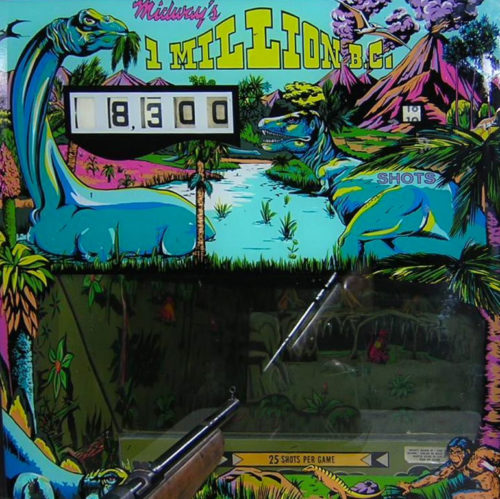-
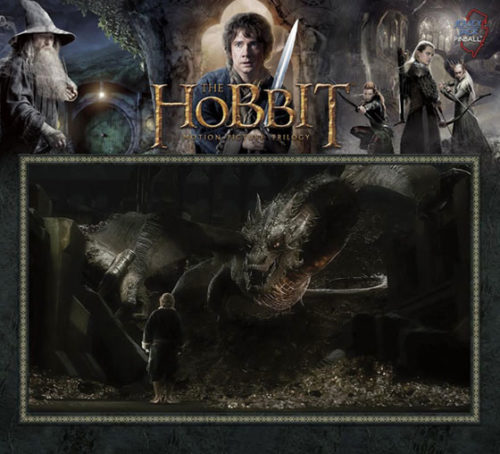 •27” HD LCD Display featuring full color custom animation, movie clips, scoring, attract mode, back glass artwork and more.. •Standard stainless steel spring-loaded metal lockdown bar and side armor •RGB-LED Playfield Lighting •Super-White LED GI Lighting •Full color digitally printed cabinet and back box artwork •7 Speaker 2.1 Digital Audio system. •Each game will have a number affixed to the game apron to be seen under the playfield glass… •Premium Clear Coated Playfield
•27” HD LCD Display featuring full color custom animation, movie clips, scoring, attract mode, back glass artwork and more.. •Standard stainless steel spring-loaded metal lockdown bar and side armor •RGB-LED Playfield Lighting •Super-White LED GI Lighting •Full color digitally printed cabinet and back box artwork •7 Speaker 2.1 Digital Audio system. •Each game will have a number affixed to the game apron to be seen under the playfield glass… •Premium Clear Coated Playfield -
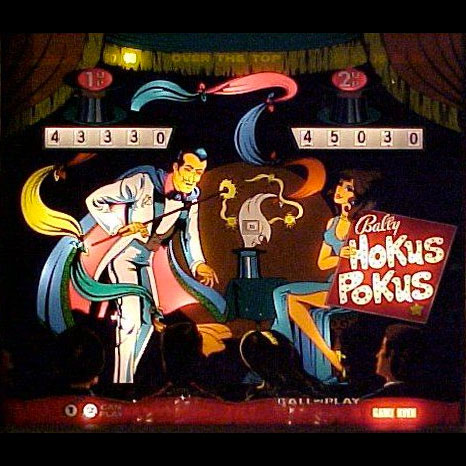
-
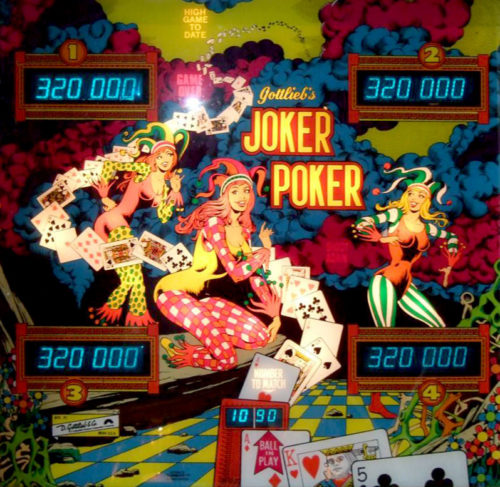 Gottlieb Joker Poker pinball. An interesting design, and only made in a 4 player version (no 2 player, unusual for Gottlieb pinball). One bank of five ace drop targets, one bank of four king drop targets, one bank of three jack targets, one bank of two queen drop targets, and a single ten drop target. Pretty cool pinball design really. Two pop bumpers, one slingshot, two 3″ flippers. They made 820 Gottlieb EM Joker Poker pinballs.
Gottlieb Joker Poker pinball. An interesting design, and only made in a 4 player version (no 2 player, unusual for Gottlieb pinball). One bank of five ace drop targets, one bank of four king drop targets, one bank of three jack targets, one bank of two queen drop targets, and a single ten drop target. Pretty cool pinball design really. Two pop bumpers, one slingshot, two 3″ flippers. They made 820 Gottlieb EM Joker Poker pinballs. -
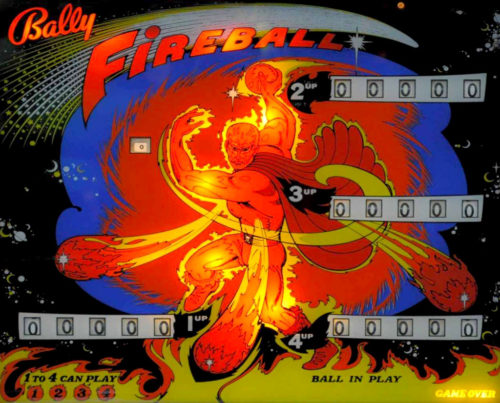 This is it. The ultimate collectible game of the ‘70s according to the literature. Bally put together Ted Zale and Dave “Mad Dog” Christianson to design the game. Production run was 3,815 units. Many firsts here. The whirlwind spinning disk was a first to throw off the ball once rolled upon. A messenger ball (captive ball) was a variation on a theme. The art package is truly amazing. A lower-left kick-back kicker, when activated, returns your ball to play. A free ball gate returns your ball to the plunger. “Zipperflippers”, a first, closes the gap between the flippers, when activated, preventing the loss of the ball thru the center drain until turned off. Once you lock two balls in the “odin” and “wotan” kickout holes, then hit “release messenger balls”, three balls are in play. No jackpot in multiball in this game was developed. You just had a period of high scoring and pinball chaos to contend with until you lost the first two balls in play.
This is it. The ultimate collectible game of the ‘70s according to the literature. Bally put together Ted Zale and Dave “Mad Dog” Christianson to design the game. Production run was 3,815 units. Many firsts here. The whirlwind spinning disk was a first to throw off the ball once rolled upon. A messenger ball (captive ball) was a variation on a theme. The art package is truly amazing. A lower-left kick-back kicker, when activated, returns your ball to play. A free ball gate returns your ball to the plunger. “Zipperflippers”, a first, closes the gap between the flippers, when activated, preventing the loss of the ball thru the center drain until turned off. Once you lock two balls in the “odin” and “wotan” kickout holes, then hit “release messenger balls”, three balls are in play. No jackpot in multiball in this game was developed. You just had a period of high scoring and pinball chaos to contend with until you lost the first two balls in play. -
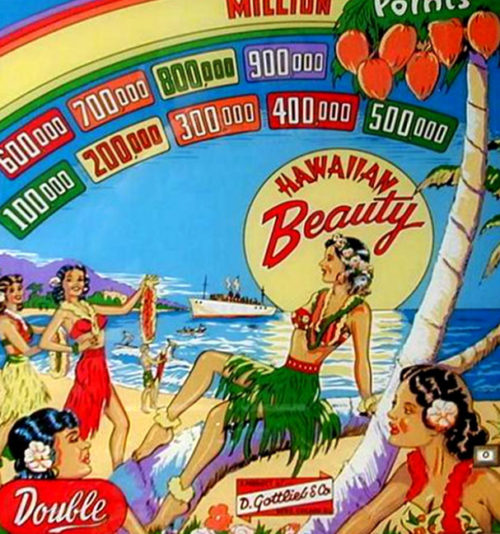 If there was a very pretty game manufactured in the ‘50s, this is it! Hawaiian Beauty was designed by Wayne Neyens with art package by none other than Roy Parker. 900 of these machines were screwed together in the Chicago factory. The game was initially called “Monkey Shine” but was later changed. This game also features the infamous “double” award. If you inset two nickels at the beginning of the game instead of the usual nickel, each won replay would score two games or double the winnings instead of one game. More coins in the coinbox was the hope of the arcade owners. The playfield is interesting in this game. Two blocked gobble holes at the top of the playfield would score 500,000 points and light lower side exit special lanes for replays. Hitting the 1-6 sequence at the top of the playfield would advance the rollovers to score 100,000 points if rolled over. Points as well as score won games.
If there was a very pretty game manufactured in the ‘50s, this is it! Hawaiian Beauty was designed by Wayne Neyens with art package by none other than Roy Parker. 900 of these machines were screwed together in the Chicago factory. The game was initially called “Monkey Shine” but was later changed. This game also features the infamous “double” award. If you inset two nickels at the beginning of the game instead of the usual nickel, each won replay would score two games or double the winnings instead of one game. More coins in the coinbox was the hope of the arcade owners. The playfield is interesting in this game. Two blocked gobble holes at the top of the playfield would score 500,000 points and light lower side exit special lanes for replays. Hitting the 1-6 sequence at the top of the playfield would advance the rollovers to score 100,000 points if rolled over. Points as well as score won games. -
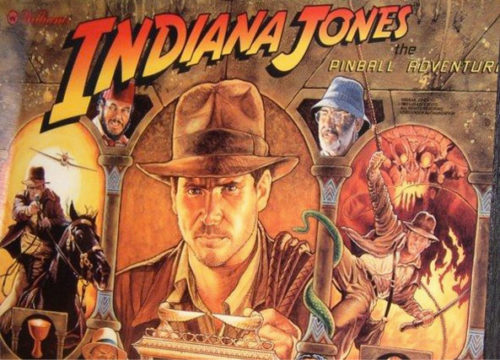 12,716 of these Mark Ritchie-designed games were produced in wide-body format. This machine has a lot of the action associated with the first three Indiana Jones adventures produced by Lucas and Spielberg and is rated in the top 10 machines of the ‘90s. Four multiball modes grace this machine as well as a ton of video clips designed by Brian Eddy. Twelve different scenes from the movies are represented. Completing these scenes awards a six-ball multiball sequence. A three-ball multiball sequence may be had by hitting the center drop targets and popping a ball into the drop hole behind them. The path of adventure is lit by hitting the letters in the word “adventure.” Doing so opens the path up the right ramp to the tilt-a-matic playfield in the upper left. The object here is to use the flipper buttons to guide the ball to glory.
12,716 of these Mark Ritchie-designed games were produced in wide-body format. This machine has a lot of the action associated with the first three Indiana Jones adventures produced by Lucas and Spielberg and is rated in the top 10 machines of the ‘90s. Four multiball modes grace this machine as well as a ton of video clips designed by Brian Eddy. Twelve different scenes from the movies are represented. Completing these scenes awards a six-ball multiball sequence. A three-ball multiball sequence may be had by hitting the center drop targets and popping a ball into the drop hole behind them. The path of adventure is lit by hitting the letters in the word “adventure.” Doing so opens the path up the right ramp to the tilt-a-matic playfield in the upper left. The object here is to use the flipper buttons to guide the ball to glory. -
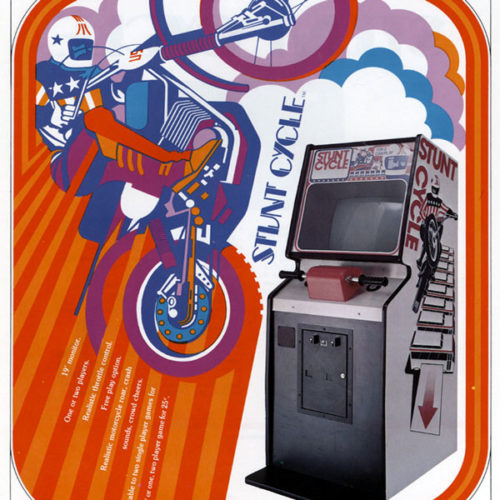
-

-
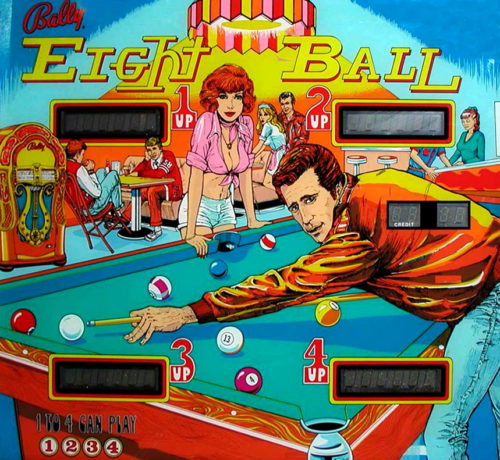 If you like “Happy Days” of TV fame, you’ll immediately notice “The Fonz” on the backglass. George Christian designed this machine and Paul Faris penned the artwork package. The machine was very popular in the early days of solid-state pinball. 20,230 games were made and most of them were played down to the wood subsurface under the artwork due to excessive play. The pool-themed game is set up so that players one and three’s goal is to score balls 1 to 7 and players two and four are after the 9 to 15 balls. Once completed, the eight-ball target lights. This machine has a built-in memory recall of each player’s efforts and the game continues on your next ball where you left off. Bonus awards are 3,000 points per ball lit with a holdover feature from your previous accomplishments. The right bonus lane advances the winnings by 2x, 3x, 5x , super bonus, extra balls and specials.
If you like “Happy Days” of TV fame, you’ll immediately notice “The Fonz” on the backglass. George Christian designed this machine and Paul Faris penned the artwork package. The machine was very popular in the early days of solid-state pinball. 20,230 games were made and most of them were played down to the wood subsurface under the artwork due to excessive play. The pool-themed game is set up so that players one and three’s goal is to score balls 1 to 7 and players two and four are after the 9 to 15 balls. Once completed, the eight-ball target lights. This machine has a built-in memory recall of each player’s efforts and the game continues on your next ball where you left off. Bonus awards are 3,000 points per ball lit with a holdover feature from your previous accomplishments. The right bonus lane advances the winnings by 2x, 3x, 5x , super bonus, extra balls and specials. -
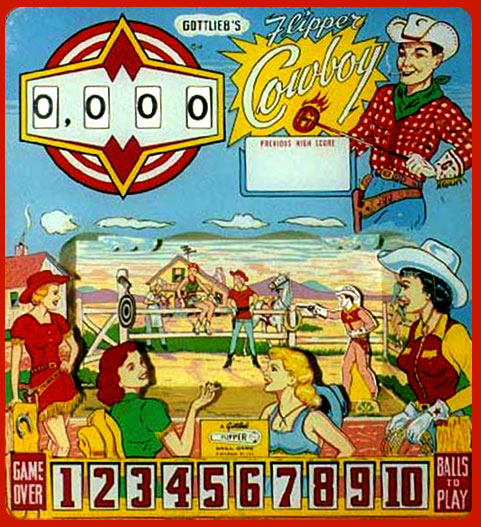 This Gottlieb game is one of the five in the museum of the “flipper” series from Gottlieb. These games are all add-a-ball games. The layout of this game parallels a future Gottlieb classic by the name of “Buckaroo” (also in the museum). 1,550 of these machines were manufactured. Wayne Neyens designed the game and Roy Parker established the art package. Fifteen targets on the roto-target are present and spinning the roto would bring up new numbers to complete. If you are skillful enough to sequence four numbers in a row, an extra ball is awarded. The bull’s-eye target awards an extra ball also. Each time an extra ball is awarded, the backglass animation activates. The cowboy shoots at the targets, which causes them to spin. No match feature here and tilting the game forfeits the ball in play as well as a future ball in play.
This Gottlieb game is one of the five in the museum of the “flipper” series from Gottlieb. These games are all add-a-ball games. The layout of this game parallels a future Gottlieb classic by the name of “Buckaroo” (also in the museum). 1,550 of these machines were manufactured. Wayne Neyens designed the game and Roy Parker established the art package. Fifteen targets on the roto-target are present and spinning the roto would bring up new numbers to complete. If you are skillful enough to sequence four numbers in a row, an extra ball is awarded. The bull’s-eye target awards an extra ball also. Each time an extra ball is awarded, the backglass animation activates. The cowboy shoots at the targets, which causes them to spin. No match feature here and tilting the game forfeits the ball in play as well as a future ball in play. -
 Centipede is a vertically oriented shoot ‘em up arcade game produced by Atari, Inc. in 1981. The game was designed by Ed Logg along with Dona Bailey, one of the few female game programmers in the industry at this time. It was also one of the first arcade coin-operated games to have a significant female player base, after Pac-Man. The player defends against centipedes, spiders, scorpions and fleas, completing a round after eliminating the centipede that winds down the playing field. The player is represented by a small, “somewhat humanoid head” at the bottom of the screen. The player moves the character about the bottom area of the screen with a trackball and fires laser shots at a centipede advancing from the top of the screen down through a field of mushrooms. Shooting any section of the centipede creates a mushroom; shooting one of the middle segments splits the centipede into two pieces at that point. Each piece then continues independently on its way down the board, with the first section of the rear piece becoming a new head. If the head is destroyed, the section behind it becomes the next head. The centipede starts at the top of the screen, traveling either left or right. When it hits a mushroom or the edge of the screen, it drops one level and switches direction. Thus, more mushrooms on the screen cause the centipede to descend more rapidly. The player can destroy mushrooms by shooting them, but each takes four hits to destroy. If the centipede reaches the bottom of the screen, it moves back and forth within the player area and one-segment “head” centipedes are periodically added. This continues until the player has eliminated both the original centipede and all heads. When all the centipede’s segments are destroyed, a new centipede forms at the top of the screen. Every time a centipede is eliminated, however, the next one is one segment shorter and is accompanied by one additional, fast-moving “head” centipede. A player loses a life when hit by a centipede or another enemy, such as a spider or a flea. The flea leaves mushrooms behind when fewer than five are in the player area, though the number required increases with level of difficulty. Spiders move across the player area in a zig-zag fashion and occasionally eat some of the mushrooms. Scorpions poison every mushroom they touch, but these never appear in the player’s movement region. A centipede touching a poisoned mushroom hurtles straight toward the player’s area. Upon reaching the player’s area, the centipede returns to normal behavior.
Centipede is a vertically oriented shoot ‘em up arcade game produced by Atari, Inc. in 1981. The game was designed by Ed Logg along with Dona Bailey, one of the few female game programmers in the industry at this time. It was also one of the first arcade coin-operated games to have a significant female player base, after Pac-Man. The player defends against centipedes, spiders, scorpions and fleas, completing a round after eliminating the centipede that winds down the playing field. The player is represented by a small, “somewhat humanoid head” at the bottom of the screen. The player moves the character about the bottom area of the screen with a trackball and fires laser shots at a centipede advancing from the top of the screen down through a field of mushrooms. Shooting any section of the centipede creates a mushroom; shooting one of the middle segments splits the centipede into two pieces at that point. Each piece then continues independently on its way down the board, with the first section of the rear piece becoming a new head. If the head is destroyed, the section behind it becomes the next head. The centipede starts at the top of the screen, traveling either left or right. When it hits a mushroom or the edge of the screen, it drops one level and switches direction. Thus, more mushrooms on the screen cause the centipede to descend more rapidly. The player can destroy mushrooms by shooting them, but each takes four hits to destroy. If the centipede reaches the bottom of the screen, it moves back and forth within the player area and one-segment “head” centipedes are periodically added. This continues until the player has eliminated both the original centipede and all heads. When all the centipede’s segments are destroyed, a new centipede forms at the top of the screen. Every time a centipede is eliminated, however, the next one is one segment shorter and is accompanied by one additional, fast-moving “head” centipede. A player loses a life when hit by a centipede or another enemy, such as a spider or a flea. The flea leaves mushrooms behind when fewer than five are in the player area, though the number required increases with level of difficulty. Spiders move across the player area in a zig-zag fashion and occasionally eat some of the mushrooms. Scorpions poison every mushroom they touch, but these never appear in the player’s movement region. A centipede touching a poisoned mushroom hurtles straight toward the player’s area. Upon reaching the player’s area, the centipede returns to normal behavior. -
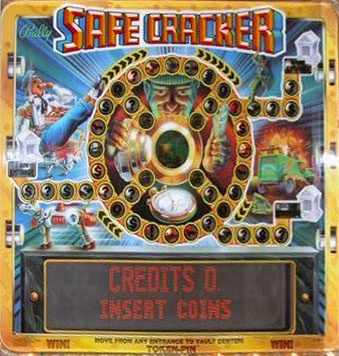 Safecracker is a pinball machine with a safecracking theme, designed by Pat Lawlor, and distributed by Midway (under the Bally label). It was created in 1996. About 1148 were manufactured. Safecracker differs from a standard pinball game in that the player is playing against the clock as opposed to having a certain number of balls available. If the player loses a ball, as long as there is time left on the clock they can continue playing. The machine is smaller in size than a standard pinball machine. The main objective of the game is to break into the bank’s safe. The game can be broken into 3 areas of play: The pinball playfield has numerous targets, the completion of which will allow entry into the bank via the rooftop, the cellar, or the front door. Once the player has entered the bank, the game changes to a boardgame that takes place on the backglass. Using the flipper buttons to make choices, the player rolls dice and moves their piece around the board while being chased by the security guard. The object of this portion of the game is to advance to the center of the game board (where the safe is located) before being caught by the guard. If the player is successful, the game will eject a “magic token” from the bank vault for the player to catch as it rolls down the playfield glass. After the player is done with the regular game, they can deposit their “magic token” into the token slot of the machine to activate a special game mode called “Assault on the Vault”. In this frenzied 4-ball multiball mode, players have 90 seconds to hit as many drop target and ramp shots as possible to break into the bank vault.
Safecracker is a pinball machine with a safecracking theme, designed by Pat Lawlor, and distributed by Midway (under the Bally label). It was created in 1996. About 1148 were manufactured. Safecracker differs from a standard pinball game in that the player is playing against the clock as opposed to having a certain number of balls available. If the player loses a ball, as long as there is time left on the clock they can continue playing. The machine is smaller in size than a standard pinball machine. The main objective of the game is to break into the bank’s safe. The game can be broken into 3 areas of play: The pinball playfield has numerous targets, the completion of which will allow entry into the bank via the rooftop, the cellar, or the front door. Once the player has entered the bank, the game changes to a boardgame that takes place on the backglass. Using the flipper buttons to make choices, the player rolls dice and moves their piece around the board while being chased by the security guard. The object of this portion of the game is to advance to the center of the game board (where the safe is located) before being caught by the guard. If the player is successful, the game will eject a “magic token” from the bank vault for the player to catch as it rolls down the playfield glass. After the player is done with the regular game, they can deposit their “magic token” into the token slot of the machine to activate a special game mode called “Assault on the Vault”. In this frenzied 4-ball multiball mode, players have 90 seconds to hit as many drop target and ramp shots as possible to break into the bank vault. -
